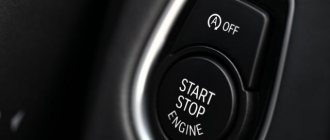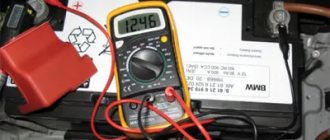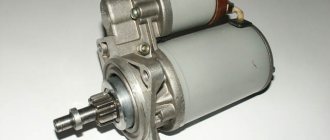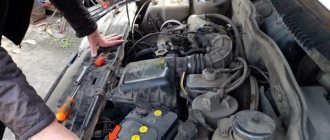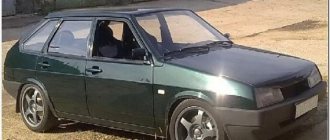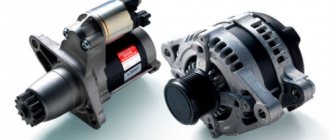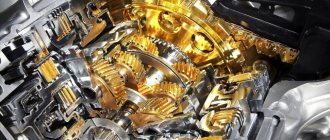Main technical characteristics
When repairing or replacing a starter, it is important to know its technical characteristics.
The main parameters include:
- Power is an indicator that is determined by the minimum starting speed, as well as the crankshaft cranking resistance. The parameter depends on the type of vehicle. So, for passenger cars the starter power is 1-2.2 kW, for freight vehicles - 4-8 kW, for tractors - 1.6-4 kW, and for special equipment - up to 9 kW. The parameter may vary depending on the engine type. To find out the power parameter of the car’s starter, just look at the car’s passport.
- Moment of resistance to rotation. In a car starter, the indicator depends on the engine size. The higher the latter, the greater the moment of resistance.
- Minimum starting frequency. This parameter depends on the characteristics of the ignition cycle in the engine, as well as the conditions for the formation of the combustible mixture. Thus, in engines running on gasoline, a starter is installed with a starting frequency of 40-50 rpm. If we are talking about a truck or diesel engine, this parameter is 80-250 rpm.
Is it possible to use a battery with a high starting current?
Contrary to popular belief that installing a more powerful battery will lead to failure of car electronics, including the starter, we should recall the school physics course, which explains the basic patterns of electricity consumption. Regardless of the power of the battery, the devices will consume only the required amount of electricity, and the starter can fail only if the limit for a single start of this element of the vehicle’s electrical system is significantly exceeded.
Difficulties with installing a more powerful battery can arise only due to insufficient space in the engine compartment. The greater the power of the battery, the larger its dimensions. The length of the product increases especially significantly with increasing capacity and power, so it is possible to install a product in its standard location that significantly exceeds the standard battery in power for a given model of car only after making changes to the design of the battery installation location.
How to measure the starting current of a starter?
First of all, do not repeat the mistake of some car enthusiasts who once tried to measure the starter inrush current using a multimeter. How they acted. The multimeter in ammeter mode was connected to the gap of one of the terminals on the battery. That is, the terminal was removed, one probe was applied to the battery, the second to the disconnected wire. Then the engine was started, but no one recognized the starter current in this way.
And all because the multimeters that many car enthusiasts have are not designed to measure current strength more than 10-20 A. And the starter of even a small car consumes at least 100 A. Accordingly, this method of measurement will always lead to the same outcome – multimeter combustion. Such experiments are especially dangerous with cheap devices in which the ammeter is included in the system without a fuse.
Methods for checking inrush current
Now you need to learn how to check the starting current of the battery. This parameter must be checked when purchasing a new battery. Self-checking the starting current will not provide high accuracy. Professional and accurate measurements require expensive equipment.
How to measure the starting current of a battery using instruments and other “folk” methods:
- Check using a load fork. A load fork is a portable battery tester that consists of a voltmeter and an additional resistance. When connected to the battery, the load plug replaces the load of the vehicle's on-board network.
Important! The load plug will show the condition of the battery and its state of charge. But if the battery is working properly, this means that it supplies the necessary starting current to crank the starter.
- Checking with a clamp meter. Electrical clamps are an inexpensive and accessible device that is used by many electricians. There are universal measuring instruments, in addition to current, measuring voltage and resistance. Clamps are specially designed to measure current, so a large amperage will not damage the device.
- A simple old-fashioned method advises connecting the car battery to the car’s on-board electrical network and turning on, for example, the low beam. A standard load should not quickly discharge the battery. For 5-10 minutes, the low beam headlights should remain bright. This method will not give an exact guarantee, but it will help to identify a serious malfunction immediately and not buy a defective product.
- Test by ear. During such a test, the battery must be installed in the car and the starter must be started. The average engine starting time (with a working fuel system) is 2-3 seconds. If the start occurs within 10-15 seconds, and the battery parameters are suitable for this type of car, then the battery is faulty or its starting current is insufficient.
How do factories check starting current? Before launching a battery into large-scale production, the manufacturer must ensure that all battery parameters comply. To do this, the battery is placed in an ambient temperature of no more than 18 degrees for several hours, and the engine is started with suitable parameters. When starting, the starting current of the new battery is measured.
Advice! Do not attempt to measure the starting current while the starter is cranking using the current mode on the multimeter. This measuring device is not designed for high currents and such a measurement will only lead to its damage.
If the launch is successful (the average time should not exceed 30 seconds), then mass production of such a battery can begin. If the engine does not start, then the battery design requires changes and modifications.
We give definitions
When studying the features of a starter, it is worth highlighting the following terms:
- Starter power is a parameter that characterizes the amount of energy developed by a DC motor during the engine starting process. The nameplate and rated power are equal when the starter rotates without load. At the moment of startup, inrush currents arise that are several times greater than the rated current.
- The minimum starting frequency is a parameter by which one can judge the crankshaft speed under optimal conditions for mixture formation and ignition.
- Torque of resistance to rotation - the value of the torque of resistance to rotation of the motor shaft.
What is inrush current and what does it depend on?
The starting current is also called the cold cranking current, which indicates the main value of this parameter for the machine. When the engine is not warmed up, the oil in it is in a more viscous state, so at the moment of starting, the starter consumes a large amount of electricity.
Considering the extremely low resistance of the electric motor winding, in order to perform the work of rotating the rotor, it will be necessary to supply high-power electricity from the battery, and the higher the cold cranking current, the easier it will be to start the car.
The power of the electric current is calculated using the formula: P=UI.
In this expression, P is power; U – voltage; I – current strength. The voltage of a healthy battery is approximately 12 Volts, therefore, the higher the current value, the higher the power the starter motor can develop. You should also take into account the fact that at the moment the electric engine starts, this parameter is always higher than when its speed increases significantly, so the car starter battery must have a significant reserve for this indicator.
The starting current of the battery depends on the number of lead plates. That is, the larger the area of both negative and positive electrodes, the higher the cold cranking current will be.
Why do you need to know the starting current of the starter?
First of all, in order to choose the right battery if it’s time to replace the old one. If you don’t pay attention to this parameter, chasing an attractive price or ampere-hour capacity, you may encounter the fact that the new battery will not be able to crank your starter normally, or will not budge it at all.
As a rule, on all modern car batteries this characteristic is indicated under the guise of maximum starting current. That is, at first glance, there should be no difficulties with the choice. However, there are several nuances here. Let's look at them.
- Firstly, it must be taken into account that the maximum starting current indicated on the battery case can only be delivered in a fully charged state. That is, when the new battery one day turns out to be discharged for one reason or another, for example, by half, the starting current that it will be able to produce will decrease.
- Secondly, the maximum starting current indicated on the case will steadily decrease with each day the battery is used. So, if new and fully charged it is capable of delivering 400 A (as written), then after six months this characteristic may decrease to 300 A, and so on.
- Thirdly, it would not be amiss to remember that some exaggerate the characteristics of manufactured products. This means that with the 500 A indicated on the case, the maximum starting current will actually not reach this figure. In some cases, measurements showed that this parameter was as much as twofold. Fortunately, such cases are rare today. But we need to remember them. There are special electronic devices to check the true maximum starting current of the battery.
Further, it is necessary to take into account that the car is not always operated under the same conditions and in ideal technical condition. This means that the battery must be selected with a reserve in terms of starting current - the more, the better.
Some car enthusiasts have a misguided fear that the excessively high starting current indicated on the battery will burn out the starter. This is wrong. The starter will never take more current than it needs. So, if the battery says that the maximum current is 600 A, this does not mean that exactly this current will go to the starter. No. He will only take “his” prescribed 150-200 A.
This concerns the choice of battery. However, knowing your starter's inrush amps is useful for other purposes as well. Including increased energy consumption, it is possible to promptly identify some problems with the machine. If the starter current consumption has increased, this may indicate wear, clogging, short circuits in the windings, poor contact and other breakdowns. By eliminating these shortcomings in a timely manner, you will reduce the load and wear of the battery. Accordingly, it will last longer, and the engine will start easier even despite severe frosts.
Selection options
When replacing a battery, you need to understand that you do not need to buy a device with less power than the old one.
At the same time, you should not take a battery with a weaker capacity than it had before. The fact is that in different operating modes of the car, with a short mileage during the day and at night, the battery, as it were, helps the generator power all the switched on devices, and the reduced capacity will significantly complicate the operation of the battery during startup. Therefore, you need to correctly select the appropriateness of all indicators. To summarize, we can say that batteries with high starting power can fail in severe frosts just like weak models. The point here is not even about power, but about the fact that any car battery requires constant care. At the same time, batteries that are considered permanent also require such maintenance. The fact is that any battery needs to be periodically charged after a long urban driving cycle. In addition, do not forget about periodic diagnostics and measurements of the starting current.
When choosing a battery, you should not forget about some of the features of each car.
What determines the service life of a device?
The service life of a car starter largely depends on several factors - the level of engine wear, battery capacity, and vehicle mileage.
The average lifespan of the most wearable elements (bushings, couplings and rotors) is 80-120 thousand kilometers. In general, a car starter lasts 5-6 years with intensive vehicle use.
When used in a large city, the service life is reduced to 3-4 years. To extend starter life, three components are required:
- Taking preventive measures;
- Timely diagnosis of problems;
- Qualified repairs.
How to reduce the starter inrush current?
Doing this is very useful, first of all, for the battery. After all, the less current the starter consumes, the longer it will last. This will also significantly increase the chances of successfully starting the engine in cold weather, and even with a partially discharged battery.
There are several ways to reduce the starter inrush current. It is advisable to use them comprehensively and regularly. Let's look at the main ones.
First, you need to ensure normal contact at the junction of the power wires with the battery and starter. Oxides and rust must be removed from the contact pads and terminals, and then everything must be securely secured in place (unless the starter will not be removed to perform the following steps).
Next, to reduce the starting current, you need to remove the starter from the car and disassemble it. bronze bushings , which act as plain bearings, are to blame here If they are worn out (there is noticeable lateral play of the rotor), replace them with new ones. If there is no wear, then the bushings must be thoroughly cleaned and lubricated before assembly.
How to reduce harm from inrush current?
If it is impossible to change the engine power supply circuit (for example, a neighbor in the country starts a lathe every half hour, and no “methods of influence” have any effect), then various methods can be used to minimize harm from starting currents. For example:
- Install an inverter UPS (UPS) for important consumers or for the entire house, which will keep the voltage normal in any situation. The most expensive but effective way.
- Install a voltage stabilizer. But keep in mind that not all stabilizers are equally useful. Sometimes they may not cope, and sometimes they may even make the situation worse. For more details, follow the link provided.
- If the power supply is single-phase, then you can try switching from the “bad” phase to the “good” one. Sometimes this method is as effective as using a teleport instead of the Taganrog-Moscow bus.
But I remind you that we are not dealing with eliminating consequences, but preventing problems, so let’s move on.
A few words about capacity
However, voltage is only one of the components; it is unified, that is, it is the same for all batteries, regardless of capacity.
But the capacity can differ significantly. It is measured in Amperes per hour, or simply Ah. If we derive a small definition, then this is the ability of a battery to deliver a certain amount of current for an entire hour. Automotive options start at 40 Ah and go up to 150 Ah. However, the most common ones on ordinary foreign cars are 55 – 60 Ah. That is, the battery can deliver 60 Amps for an hour, and then it will be completely discharged. To be honest, this is a big value, if you multiply 12.7 (voltage) and 60 Ah (capacity), you get 762 Watts per hour! You can warm up the electric kettle a couple of times.
We also sorted out the capacitance, now let’s talk directly about the starting current.
Causes of starting power
Considering different battery manufacturers from Europe, the USA, China and Russia, we can conclude that they all produce batteries with different starting current strengths. For example, batteries with a capacity of 60 amperes per hour may differ in this value by 35-45%.
It depends on the production technology:
- Using purified lead for production will lead to faster charging and discharging of the battery and, accordingly, will increase starting power.
- The body dimensions are the same, but the number of lead plates in them is different.
- The volumes of electrolyte in such batteries differ.
- Plus plates have more pores, allowing more charge to be stored.
- Thanks to a more hermetically sealed housing, the electrolyte does not evaporate and always fills the plates.
In addition, you can add the quality of production and the integrity of the manufacturer. All of these factors influence the inrush current results. But, on the other hand, their price is much higher than that of their competitors.
Today there are more powerful technologies that allow you to get a current of 1000 amperes in 30 seconds. Among the leaders are batteries such as GEL and AGM. Although their significant disadvantage can be considered their very high price.
We recommend: How much electrolyte is in the battery 60 and 132
In addition, it should be noted that when the engine starts and voltage is applied to the starter, the voltage drops to approximately 9 volts, but the cold current increases greatly. This process is how it should happen and is considered normal. After starting, the voltage increases again to the usual 12.7 volts, and the lack of energy spent at start is compensated by the car’s generator.
In the case when the voltage drops to 6 volts and takes a very long time to recover, most likely the battery is faulty and needs to be replaced.
Starting a hot engine
The launch was carried out at a temperature of about 0 degrees. The voltage on the battery before start is 12.80 Volts.
Starting current of a car starter with a hot gasoline engine
The current when starting a hot engine with the clutch depressed reached 170 Amperes
2.Be sure to depress the clutch when starting the engine (when turning the key). This way you disconnect the gearbox from the engine and the starter does not need to turn all the gears of the gearbox along with the engine. Thickened oil in the gearbox can cause the starting current to double. In the engine, the oil also thickens, but it is less viscous and usually less resistant to cranking the starter.
3. Turn off all appliances before turning the key. It is necessary to turn off the side lights, interior lighting, radio, heated seats or rear window if these can be turned on when the ignition is on.
If the engine does not start even if all the rules described above are followed, most likely your battery is dead.
What should be the starting current to start the engine?
The starting current for starting an engine of a certain brand must be calculated at the power unit manufacturer. The indicators of this parameter increase with increasing its capacity, so if you know what kind of battery was in the car, you can easily select a new battery based on capacity. In this case, the electrical parameters will fully correspond to the make and type of car.
If it is necessary to install a battery on a vehicle that did not have a battery, then products with the following minimum cold cranking current values are selected:
How are measurements taken?
After the battery is produced, it must be tested to determine the starter voltage. Tests in production are complex; batteries are often placed in subzero temperatures, cooled for several hours, and then tried to start the engine.
Usually the tests take place at -18 degrees Celsius and the start-up lasts 30 seconds; if the battery copes, then it can be put into production. If not, change the design, filling, and carry out tests on a new one.
They measure several times, that is, there are a number of intervals with maximum values, during such intervals the maximum currents that this particular instance is capable of producing are measured, they are recorded and later applied to the “sides” of the battery. It should be noted that not all batteries in the batch are tested so strictly. However, “defects” are present, and checks are carried out with a load fork.
In fairness, it is worth noting that earlier in Soviet times, batteries were not filled with electrolyte at all in production (there was a concept of a dry charge), you yourself had to fill and charge them! That is, we buy an electrolyte of the required density, and then charge it for 12 – 24 hours.
Increased battery performance
Today, starting values need to be divided into devices for diesel engines and gasoline engines. Indeed, in diesel engines, the starter voltage indicators are much higher than in gasoline engines, since the compression in the air cylinder is much higher and can reach up to 20 atmospheres.
Therefore, you can focus on averages:
- in gasoline engines 250 atmospheres;
- in diesel engines - 300 atmospheres.
These figures can be relied upon at 18 degrees below zero, which will not be sufficient at all in more severe frosts.
Today in stores you can find batteries with starting power ratings of even 600 amperes.
Many people worry about this because they can burn the starter with such voltage. But in this case there is no need to worry. It is impossible to burn the starter in this way, and if possible, it is better to take a more powerful battery and forget about how difficult it is to start in severe frosts. Everything is clear about the starter here. This will not damage it in any way, but will only increase the speed when starting, which, in turn, will lead to a quick and high-quality start of the engine. Therefore, do not be afraid if the starting current of the battery is higher than the standard one.
We recommend: How to properly change the electrolyte in a battery
Of course, you need to take into account the characteristics of the car, but a starter current of 300-400 amperes will be enough for almost all regions of the country. This applies to passenger cars.
For large machines, 600 amperes will often not be enough.


